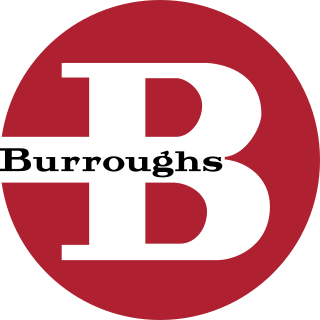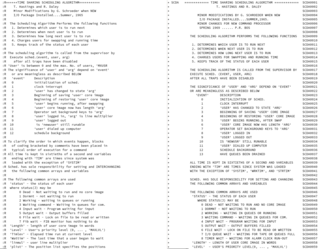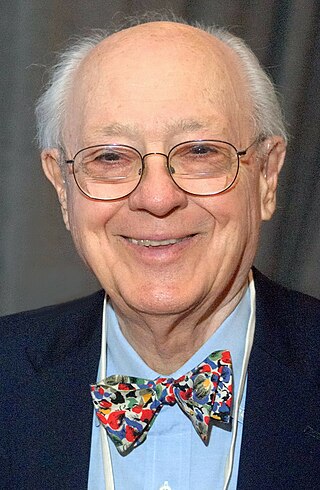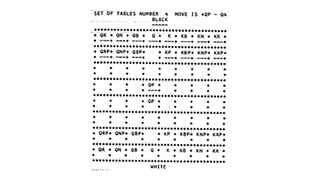Related Research Articles

The Burroughs Corporation was a major American manufacturer of business equipment. The company was founded in 1886 as the American Arithmometer Company. In 1986, it merged with Sperry UNIVAC to form Unisys. The company's history paralleled many of the major developments in computing. At its start, it produced mechanical adding machines, and later moved into programmable ledgers and then computers. It was one of the largest producers of mainframe computers in the world, also producing related equipment including typewriters and printers.
MAD is a programming language and compiler for the IBM 704 and later the IBM 709, IBM 7090, IBM 7040, UNIVAC 1107, UNIVAC 1108, Philco 210-211, and eventually IBM System/370 mainframe computers. Developed in 1959 at the University of Michigan by Bernard Galler, Bruce Arden and Robert M. Graham, MAD is a variant of the ALGOL language. It was widely used to teach programming at colleges and universities during the 1960s and played a minor role in the development of Compatible Time-Sharing System (CTSS), Multics, and the Michigan Terminal System computer operating systems. The original version of the chatbot ELIZA was written in MAD-SLIP.

The IBM 704 is a large digital mainframe computer introduced by IBM in 1954. It was the first mass-produced computer with hardware for floating-point arithmetic. The IBM 704 Manual of operation states:
The type 704 Electronic Data-Processing Machine is a large-scale, high-speed electronic calculator controlled by an internally stored program of the single address type.

The IBM 7090 is a second-generation transistorized version of the earlier IBM 709 vacuum tube mainframe computer that was designed for "large-scale scientific and technological applications". The 7090 is the fourth member of the IBM 700/7000 series scientific computers. The first 7090 installation was in December 1959. In 1960, a typical system sold for $2.9 million or could be rented for $63,500 a month.

The IBM 7030, also known as Stretch, was IBM's first transistorized supercomputer. It was the fastest computer in the world from 1961 until the first CDC 6600 became operational in 1964.

The IBM 709 was a computer system, initially announced by IBM in January 1957 and first installed during August 1958. The 709 was an improved version of its predecessor, the IBM 704, and was the third of the IBM 700/7000 series of scientific computers. The improvements included overlapped input/output, indirect addressing, and three "convert" instructions which provided support for decimal arithmetic, leading zero suppression, and several other operations. The 709 had 32,768 words of 36-bit magnetic core memory and could execute 42,000 add or subtract instructions per second. It could multiply two 36-bit integers at a rate of 5000 per second.

Gene Myron Amdahl was an American computer architect and high-tech entrepreneur, chiefly known for his work on mainframe computers at IBM and later his own companies, especially Amdahl Corporation. He formulated Amdahl's law, which states a fundamental limitation of parallel computing.
This article presents a timeline of events in the history of computer operating systems from 1951 to the current day. For a narrative explaining the overall developments, see the History of operating systems.

The Compatible Time-Sharing System (CTSS) was the first general purpose time-sharing operating system. Compatible Time Sharing referred to time sharing which was compatible with batch processing; it could offer both time sharing and batch processing concurrently.

Charles William Bachman III was an American computer scientist, who spent his entire career as an industrial researcher, developer, and manager rather than in academia. He was particularly known for his work in the early development of database management systems. His techniques of layered architecture include his namesake Bachman diagrams.
The University of Michigan Executive System, or UMES, a batch operating system developed at the University of Michigan in 1958, was widely used at many universities. Based on the General Motors Executive System for the IBM 701, UMES was revised to work on the mainframe computers in use at the University of Michigan during this time and to work better for the small student jobs that were expected to be the primary work load at the University.
SIMSCRIPT is a free-form, English-like general-purpose simulation language conceived by Harry Markowitz and Bernard Hausner at the RAND Corporation in 1962. It was implemented as a Fortran preprocessor on the IBM 7090 and was designed for large discrete event simulations. It influenced Simula.

IBSYS is the discontinued tape-based operating system that IBM supplied with its IBM 709, IBM 7090 and IBM 7094 computers. A similar operating system, also called IBSYS, was provided with IBM 7040 and IBM 7044 computers. IBSYS was based on FORTRAN Monitor System (FMS) and Bell Labs' "BESYS" rather than the SHARE Operating System. IBSYS directly supported several old language processors on the $EXECUTE card: 9PAC, FORTRAN and IBSFAP. Newer language processors ran under IBJOB.
SHARE Inc. is a volunteer-run user group for IBM mainframe computers that was founded in 1955 by Los Angeles-area users of the IBM 704 computer system. It evolved into a forum for exchanging technical information about programming languages, operating systems, database systems, and user experiences for enterprise users of small, medium, and large-scale IBM computers such as IBM S/360, IBM S/370, zSeries, pSeries, and xSeries. Despite the capitalization of all letters in the name, the official website says "SHARE is not an acronym; it's what we do."
The Formatted File System (FFS) is the name of a series of Database Management Systems (DBMS) developed for military use and designed to run on IBM mainframe computers.

Kotok-McCarthy also known as A Chess Playing Program for the IBM 7090 Computer was the first computer program to play chess convincingly. It is also remembered because it played in and lost the first chess match between two computer programs.
The SHARE Operating System (SOS) is an operating system introduced in 1959 by the SHARE user group. It is an improvement on the General Motors GM-NAA I/O operating system, the first operating system for the IBM 704. The main objective was to improve the sharing of programs.
The history of IBM mainframe operating systems is significant within the history of mainframe operating systems, because of IBM's long-standing position as the world's largest hardware supplier of mainframe computers. IBM mainframes run operating systems supplied by IBM and by third parties.
DYNAMO is a simulation language and accompanying graphical notation developed within the system dynamics analytical framework. It was originally for industrial dynamics but was soon extended to other applications, including population and resource studies and urban planning.
Informatics General Corporation, earlier Informatics, Inc., was an American computer software company in existence from 1962 through 1985 and based in Los Angeles, California. It made a variety of software products, and was especially known for its Mark IV file management and report generation product for IBM mainframes, which became the best-selling corporate packaged software product of its time. It also ran computer service bureaus and sold turnkey systems to specific industries. By the mid-1980s Informatics had revenues of near $200 million and over 2,500 employees.
References
- ↑ Haigh, Thomas; Bachman, Charles W. (September 25–26, 2004). "Charles W. Bachman interview". ACM Oral History interviews. p. 2. doi: 10.1145/1141880.1141882 . ISBN 978-1-4503-1771-9.
- ↑ Andrew L. Russell (April 9, 2011). "Oral-History:Charles Bachman". IEEE Oral History Network. Retrieved September 3, 2013.